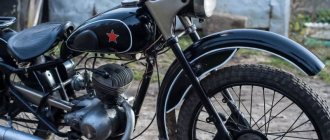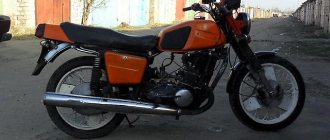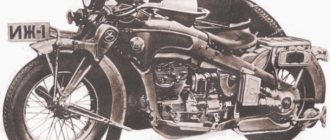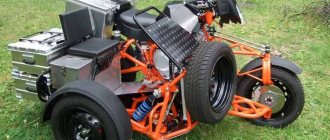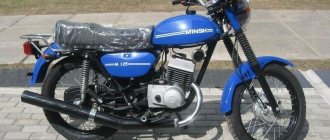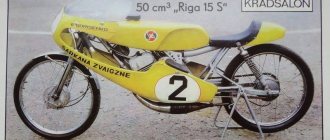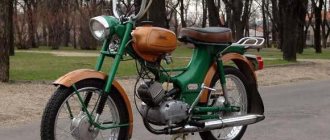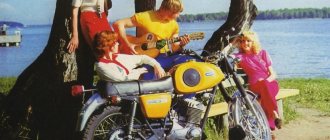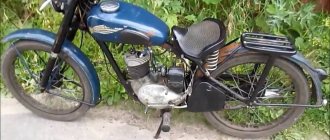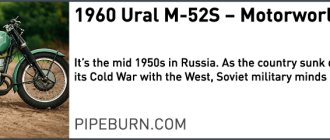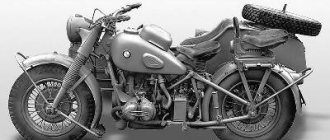The Soviet road motorcycle Voskhod was produced at the Degtyarev plant, a large defense enterprise located in the Russian city of Kovrov. The production of a light two-wheeled vehicle was established in the format of consumer goods in 1957. The Voskhod motorcycle was distinguished by its simple design and reliability in operation. Repairs were also inexpensive. In those distant times, the concept of prestige of a vehicle did not exist; a motorcycle was assessed according to its durability and affordability. The low level of comfort when riding a two-wheeled car did not bother anyone. Shaking even on a good road, vibration of all components were simultaneously considered integral characteristics of a motorcycle.
Predecessor
The prototype of the Voskhod was the German RT 125 motorcycle, manufactured by DKW. Initially, the Soviet version was called “Kovrovets”, and only a few years later the car received the name “Voskhod”. The motorcycle, photos of which were published in newspapers, immediately became popular among the general population, and its production was put into production. The name change is explained by the growing popularity of the car and its demand throughout the USSR. The new Voskhod motorcycle, the characteristics of which remained virtually unchanged, was considered the most reliable, “people's” model. The relatively low price corresponded to this postulate. The origin of the design was not advertised; Soviet consumers were confident that they were buying a domestic motorcycle, reliable and durable.
Technical specifications
Motorcycle characteristics:
- engine - two-stroke, single-cylinder;
- cylinder volume - 173.7 cubic meters. cm;
- diameter - 61.72 mm;
- piston stroke - 58 mm;
- power - 10 l. With.;
- gearbox - built-in, four-speed with lever gear shift;
- rear wheel drive - chain;
- rear suspension - pendulum;
- front suspension - telescopic;
- brakes - drum;
- maximum speed - 90 km/h;
- fuel - low-octane gasoline A72;
- weight - 110 kg.
Meeting the new "Sunrise"
Every fourth Soviet motorcycle is produced in Kovrov. The new model “Voskhod-3” has maintained the continuity traditional for this brand with the previous ones. It received a new gas tank, intake system, rear shock absorbers, gas control drive and secondary transmission damper. Voskhod-3 has modernized brakes, wheels, a generator, and an improved saddle.
This motorcycle has a long history - nine models of the 175 cm3 class with the Kovrovets and Voskhod brands. And here is the tenth anniversary “Voskhod-3”. The Kovrov plant named after V. A. Degtyarev recently completed comprehensive tests of a new road machine and will soon begin its mass production.
Design decisions are based on an analysis of the wishes of numerous consumers of our products, combined with measures developed by the plant for its further improvement.
Work on the Voskhod-3 motorcycle went in several main directions. First of all, we pursued the goal of maintaining continuity with previous models in terms of the most advanced components and parts. From the point of view of the consumer, who highly values their interchangeability, this is very important.
We clearly understood that our “sunrises” are mass-produced machines (every fourth Soviet motorcycle is produced in Kovrov) and, therefore, must equally satisfy the requirements of both city dwellers and villagers. Such versatility means that the new model must harmoniously combine the most important consumer qualities: increased comfort, ease of maintenance, high dynamics and efficiency, and attractive appearance. By the way, as practice shows, motorcyclists attach more and more importance to the latter quality. And when developing the design of the new motorcycle as a whole and its individual components, the plant took into account the requests of motorcyclists expressed in letters, oral proposals, and reports.
Now let's look at the innovations in the Voskhod-3 motorcycle.
Brake system. The diameter of the brake drums has been increased from 125 to 160 mm, which ensures high operating efficiency, as well as increased reliability and durability of the brakes.
The drive of the front and rear brakes, like the previous model, is mechanical, but now the axis of the foot lever rotates in nylon bushings and therefore does not require maintenance during operation. Wheels and hubs are reinforced. First of all, they received stronger knitting needles. The new hubs are equipped with bearings of the “204” series, which are protected by rubber sealing collars, which virtually eliminate the entry of dust and dirt into the bearing cages.
The drive of the rear wheel is still carried out by the PR12.7-1800-2 chain, which is enclosed in a casing and protected from dirt and sand by rubber covers - a design that has proven itself well on “Kovrovtsy” and “Voskhod”. Between the driven chain sprocket and the wheel of Voskhod-3, to smooth out jerks in the transmission, a damping device of six rubber inserts is installed (previously its role was played by a shaped rubber coupling).
Rear wheel suspension . The Voskhod-3 motorcycle has become more comfortable, primarily thanks to the new design of the rear springs and shock absorbers. The latter have increased energy intensity and provide high stability in operation when the ambient temperature changes. The shock absorber-spring assembly now features a four-position adjuster. It allows, depending on the load on the rear wheel, to set the most advantageous option (one of four) for pre-loading the springs. This is very important, since such a universal car as Voskhod-3 can be driven with or without a passenger, with or without luggage, on the highway or along a country road.
Shock absorbers located at an angle of 12° to the vertical provide the wheel with a travel of 105 mm, which is very significant, especially when operating on bad roads. The appearance of the new unit meets modern requirements of technical aesthetics. Exposed chrome springs, like all other specific parts, in combination with a plastic internal protective casing of the rod give it an attractive appearance.
Gas tank . Not only is it of a new design and holds 2 liters more fuel, but it has also become different in shape - it has received fashionable outlines and a completely different brand name, as if emphasizing the significance of the innovations as a whole. It should be noted that the now used mounting of the tank on the frame using rubber shock absorbers is convenient and reduces vibration. This means increased reliability and additional comfort for the driver.
The front shield has been changed in shape and has become lighter, which is important for improving the performance of the motorcycle.
Management . The steering wheel received a reel-to-reel throttle control, which has proven itself well on sports cars. It is controlled by a shorter movement of the hand than on Voskhod-2, thereby reducing the engine reaction time to the driver’s action. This short-stroke handle is reliable, comfortable and requires virtually no maintenance.
The modified design of the front brake and clutch control levers reduces the force required to press them. These levers are less dangerous for the driver if they fall, since they have balls with a diameter of 19 mm at the ends.
The saddle is upholstered in vinyl faux leather on a viscose-lavsan base with shaped embossing. Under the casing there is a lining made of artificial material such as “sypron”. All these, at first glance, small innovations together significantly affect the performance and aesthetic qualities of the machine and satisfy the most demanding motorist.
Intake system . The new design made it more efficient. In combination with an air filter, it significantly reduces intake noise. This is very important for solving the general problem of reducing noise generated by all types of mechanical transport.
The generator has undergone modernization (although its index remained the same - G427) and received a built-in non-reverse sensor. The new device completely eliminates accidental engine starting in the opposite direction, which sometimes occurs with inexperienced drivers.
Otherwise, Voskhod-3 adopted well-proven components and parts from previous models, for example, the 14-horsepower engine was taken from Voskhod-2M, albeit with some changes to further increase reliability, durability and reduce noise levels.
As fuel, the plant recommends AI-93 gasoline mixed with oils M-6V, M8V, in accordance with GOST 17479-72: MS-20, MK-22, MS-20S in accordance with GOST 21743 - 76. You can also use A-76 with those or oils. In this case, it is not necessary to change the ignition timing or adjust the carburetor, just as there is no need for an additional gasket between the head and the cylinder. The reliability of the engine when operating on the A-76 will not change; starting qualities will remain good.
Through the magazine, we express our gratitude to the numerous owners of our motorcycles for their wishes, responses, and reports that helped us in the creation of Voskhod-3.
G. MARININ, Deputy Head of the Design Bureau of the Degtyarev Plant in Kovrov
Modifications
The Voskhod motorcycle was produced for a long time without any improvements; its technical characteristics generally met consumer requirements. However, there were also complaints; some buyers expressed the opinion that the car was very noisy and unstable on the road. And although these comments were isolated, they had an effect.
In 1972, the design bureau of the plant in Kovrov began modernizing the “people's” model. The Voskhod motorcycle became known as Voskhod-2, and five years later the Voskhod-2M rolled off the assembly line, which was produced from 1977 to 1979. Radical changes in the design of the new car affected mainly the engine. With a cylinder volume of 173.7 cubic meters. cm power increased to 14 “horses” due to a modernized cylinder head and an expanded configuration of bypass channels. The compression ratio was 9.2 units. The speed increased to 105 km/h. The new engine required high-octane fuel; in the car’s passport, instead of A72 gasoline, it was designated A93.
In 1979, the Voskhod-2M motorcycle was renamed. It became known as Voskhod-3. The model was produced until 1983, and then a new, latest modification appeared. It was the Voskhod-3M motorcycle, which completed the lineup of light two-wheeled vehicles from the Kovrov plant. This last representative of a worthy family is still considered the best in its class.
Versions and photos of the Soviet motorcycle "Voskhod"
The first motorcycle "Voskhod" began in 1965. In comparison with its predecessor (K-175V), the single-cylinder two-stroke engine of the motorcycle has added power.
Motorcycle Sunrise 2
The road "Voskhod 2" replaced the initial model of this series, it was even more powerful than its "father", but this is where the main transformations ended, if you do not take into account its appearance. Updated headlights appeared, and the direction indicators became round. There were also improvements in the electronic ignition system and updated alarm devices were added. Compared to the previous model, these innovations are quite minor, but, nevertheless, they were a pleasant addition.
The new Voskhod 2 became a little faster and could reach its speed up to 95 km/h, but at the same time it “gained weight” by several kilograms.
In 1977, the improved Voskhod 2M came to replace it. The engine remains the same in volume, but has now become even more powerful. This modernization was achieved by increasing the configuration of the channels in the crankcase and cylinder. The changes also affected some details: the motorcycle suspension and shock absorbers were improved. The new bike became heavier, now weighing 121 kg and faster by as much as 10 km/h.
Following its predecessor, Voskhod 3 was released. The model, of course, has become significantly better than its predecessors. An updated intake system and brake system were installed. The driver's seat has now become more comfortable. But the maximum speed has not changed, despite the fact that the weight has increased, now it is 125 kg.
In 1984, Voskhod 3M was born. It was implemented properly and is quite reliable. The motorcycle continued its production until the end of 1992. Low and high beam indicators and a speedometer began to appear on the panel. The driver's footrests were installed and reclined. The maximum speed has not been changed, and the weight has become several kilograms less than that of Voskhod 3.
In 1985, Voskhod 3M-tourist was created. This version was equipped with strong safety arches, a completely updated steering wheel and travel equipment. But the weight, as well as the speed, were not changed.
Motorcycle tuning Voskhod
And the last reincarnation - Voskhod 3M-01, was created in 1989. Only the motorcycle engine with a reed valve was subject to significant modifications. With its help, it was possible to reduce fuel consumption to 4.2 liters per 100 km. The steering wheel has become somewhat wider, and thus more comfortable. And on this model, the Voskhod motorcycles completed their transformation, and the Sova brand continued production.
Nowadays, the production of motorcycles at the plant named after. Degtyarev is still in force, but there is now nothing in common between the Voskhod line and the plant. The latest modifications turned out to be completely unprepared for the current conditions of market competition.
Although the Voskhod motorcycle represents a classic of the last century, it is still popular in our time, and is famous for its unpretentiousness and cheap repairs. But new Ural motorcycles can compete with it.
New motorcycle "Voskhod-3M"
In the period from 1983 to 1993, the latest 3M model was produced at the Kovrov plant. Compared to its predecessors, the new motorcycle had a number of advantages, such as an increased area of finned cooling of the cylinder, the use of a carburetor made in Czechoslovakia, 12-volt electrical equipment instead of 6-volt, a modern instrument cluster (the speedometer was combined with indicator lamps for turn signals and high beam switching to near). The main wiring connections of the electrical circuit were hidden under the seat in special plastic containers. The motorcycle was equipped with a fairly powerful generator, which made it possible to do without a battery.
The front fork received corrugated protective covers, the passenger footrests and kickstarter stop became folding, and side rearview mirrors appeared on the steering wheel. And as the final touch to modernizing the motorcycle, an effective anti-theft lock was installed. As a result of all the improvements, the main goal was achieved - reducing the noise of the engine and chassis. The direct-flow muffler was replaced with a sectional one, with internal bulkheads. The design of the front fork and rear pendulum suspension has been revised, removing all joints that could cause knocking when moving. As a result of the measures taken, the noise of the motorcycle has noticeably decreased.
The history of the V.A. Degtyarev Plant (ZiD) began at the beginning of the last century, when in 1916 the decision was made to build the Kovrov Machine Gun Plant. A new round in the development of the plant is directly related to the outstanding designers V. Fedorov and V. Degtyarev, who in 1918 were sent to the Kovrov plant in order to prevent its closure and revive production. In all subsequent years, the enterprise was engaged in the production of automatic small arms, which began to arrive at the front during the Patriotic War. After the end of the war, weapons production did not stop, but at the same time the plant was tasked with starting production of civilian products, including road motorcycles.In 1946, the Kovrov plant produced the K-125 motorcycle with a single-cylinder two-stroke engine with a power of 4.25 hp, hydraulic front fork shock absorbers and a three-speed gearbox in the same block with the engine. The designers had no experience in motorcycle building, and the German model DKW-RT125 was taken as the basis for the first motorcycle. In 1949, monthly production volumes of the K-125 motorcycle reached 5 thousand units, and the enterprise itself became known as the V.A. Degtyarev Plant. The engine power of the next model K-55 was increased to 4.75 hp, and the model also received a pendulum rear wheel suspension. The K-58 motorcycle, which replaced the K-55, was equipped with a 5 hp engine. and an improved gas tank. This motorcycle was the last of the models developed on the basis of the DKW-RT125.
In 1954, a special motorcycle design bureau was created at the V.A. Degtyarev Plant, which was entrusted with the development of new models. In 1957, production of the K-125 was completed, and the new Kovrovets K-175 motorcycle rolled off the assembly line, which became the base model for a whole line of motorcycles - modifications of the K-175 and the Voskhod motorcycle. The 175 cc motorcycle has a three-speed gearbox, a two-seater cushion seat and 16-inch wheels. The K-175 motorcycle was called the “Kovrovskaya Java” because of its similarity with the Jawa-250, and the similarity was not only in appearance - the developments of Czech designers were also borrowed for the internal structure of the K-175 motorcycle. According to the official version, production of the K-175 was discontinued due to difficulties in manufacturing the teardrop-shaped gas tank and headlights. The model was replaced by the K-175A motorcycle with a four-speed gearbox and ignition from an alternator, then the K-175B model with a new carburetor and the K-175B motorcycle with a 9.5 hp engine were released. The K-175 motorcycle and its modifications were equipped with a semi-automatic clutch release, which was not used in subsequent models.
Voskhod motorcycles began to be produced at the plant in 1965 - it was a model with a 175 cc engine with 10 hp. and a four-speed gearbox. A distinctive feature of the Voskhod engine was a two-channel loop purge. The Voskhod motorcycle was equipped not only with a more powerful and advanced engine, but also with a trunk, windshield and guards. This motorcycle, accelerating up to 90 km/h, was very popular, including because of its affordable price and high maintainability - repairing the Voskhod was not difficult. The motorcycle was very economical and durable, although fans of sophisticated motorcycles often accused the first models of being “dull” and inconspicuous. While the Voskhod motorcycles were not very suitable for demonstration riding, for regular use, and especially for learning riding skills, they were considered one of the most reliable and unpretentious motorcycles of that time.
The next model was Voskhod-2, which, after modernization in 1976, received a rear light, a new universal muffler, round turn signal lights and, most importantly, an electronic contactless ignition system. Voskhod-2 was slightly heavier than its predecessor, the engine power increased slightly - by 0.5 hp, but it already reached a speed of 95 km/h. A year later, the Voskhod-2M motorcycle appeared with a 14 hp engine, an electronic contactless ignition system and a redesigned front fork. The motorcycle ran on both A-76 gasoline and high-octane 93 gasoline. Voskhod-2M gained weight (121 kg), but began to accelerate to 105 km/h. The new Voskhod-3 continued the traditions of motorcycles in this line, having received a larger fuel tank, new rear shock absorbers, a 7-volt upgraded generator and brake drums of increased diameter. The motorcycle was equipped with new wheels with wear-resistant tires, a short-stroke throttle handle and a lightweight front guard. The maximum speed remained the same, and the weight of Voskhod-3 increased by 4 kg.
The new modification of the motorcycle - the Voskhod-ZM model - was equipped with 12-volt electrical equipment, a headlight with a lens, an emergency ignition switch on the handlebar, an instrument panel above the headlight and a profiled front shield. The innovations of the Voskhod-3M motorcycle also include an anti-theft device, a kickstarter with a folding pedal, driver's folding footrests and two rear-view mirrors. This motorcycle weighed 122 kg, accelerated to 105 km/h and was considered one of the best in the Voskhod motorcycle line in terms of workmanship and reliability. In 1985, the plant produced a modification of this motorcycle - the sports and touring model “Voskhod 3M-Tourist”. The maximum speed, engine power and weight remained the same, and the motorcycle's innovations included steel roll bars, leatherette bags, luggage racks (two side and one rear) and a sports steering wheel with a crossbar. Since the beginning of the 90s, mass production of the Voskhod-ZM-01 motorcycle began with a 14 hp engine, a four-speed gearbox and a wide handlebar with a jumper.
New modifications of the Voskhod motorcycle are called “Owl”. These are enduro-type motorcycles with a sports handlebar and a shield on the headlight, which were equipped with two engine options - 175 cc and 197 cc. In the first case, the engine power was 14 hp, and in the second - 15 hp, and the speed of the Sova motorcycles was 105 km/h and 120 km/h, respectively. There is another interesting model in the plant’s line - the ZiD-200 Courier road motorcycle with a single-cylinder two-stroke engine with a power of 15 hp. The difference between the ZiD-200 motorcycle and the Sova motorcycle is that the ZiD has a mono-suspension rear wheel and a disc brake on the front wheel. For off-road driving, the plant developed a three-wheeled motorcycle “ZiD Farmer” with a 200 cc single-cylinder two-stroke engine producing 13 hp. In collaboration with the English entrepreneur N. Mason, another off-road motorcycle was developed - the two-wheeled model “ZDK-200 2ShP”. The ZDK-200 was equipped with a front fork from a Farmer motorcycle, a rear suspension of a new design and heavy wheels from an ATV. The ZDK-200 off-road motorcycle was tested both in the Caspian sands and on the winter road, after which Mason took several models to England and agreed on further deliveries. There is a separate story connected with this motorcycle, which ended with the fact that the plant stopped supplying the enterprising Englishman with the ZDK-200 2ShP, but at the same time lost the order to produce this model.
In the new millennium, Open Joint Stock Company “Plant named after V.A. Degtyareva continues to be one of the largest machine-building enterprises and produces a wide range of motor vehicles - from motorcycles to all-terrain vehicles. At the turn of 1999-2000. The ZiD-50 Pilot motorcycle, which was included in the register of “100 Best Products of Russia,” was very popular. Mokik "ZiD-50 Pilot" is a sports road model with a 50 cc four-stroke overhead valve engine with a power of 2.72 hp and a speed of 50 km/h. The line of small-capacity motorcycles also includes the ZiD-50-01 Active mokik with similar characteristics, and the ZiD-Ptakha mini mokik with a 1.5 hp engine. and a cargo mokick “ZiD-50 ZDK 2.404” with a two-stroke engine with a power of 3.5 hp. Motor vehicles for off-road driving are rolling off the plant’s assembly line today—Robinson all-terrain vehicles and Tarpan and Barkhan off-road vehicles. All new models of motorcycles are equipped with a LIFAN engine. More than 50 years of history of motorcycles of the V.A. Plant. Degtyareva has long been included in the annals of the domestic motorcycle industry. The last page of this story has not yet been written, and it is all the more interesting to follow the new developments of the plant, for which the decline did not come with the departure of Voskhod.
Voskhod brand truck
For rural residents, a special vehicle with a body for transporting agricultural products and building materials was also developed. However, the truck did not go into mass production. Since the gear ratios of the motorcycle gearbox did not correspond in any way to the speed parameters for transporting goods on rural roads. I had to drive in first gear, and this inevitably ended in overheating of the engine, as well as excessive consumption of gasoline. The engine of the Voskhod motorcycle turned out to be unsuitable for this operating mode. Transmission torque and effort were inconsistent. Attempts to remake the gearbox were also unsuccessful, and the Voskhod cargo motorcycle, the photo of which is presented on the page, was almost immediately discontinued.
History of appearance
In the post-war years, every engineer in the Soviet Union tried to find drawings of German technology and make something of their own. The designers of the Kovrov plant, which produced machine guns during wartime, after the war received the task of creating equipment that would help people in everyday life.
Despite the fact that the designers at that time had little experience in creating road motorcycles, in 1946 the first lightweight road motorcycle was produced at the Degtyarev plant.
It was equipped with a front fork and hydraulic shock absorbers. And the relay regulator, ignition switch and other devices were equipped under the seat. The circulation of these motorcycles at that time was about 5,000 per month.
After such a breakthrough in the production of motorcycle equipment, the first motorcycles were created based on the German DKW - RT 125. This project was led by N. Lopukhovsky. Model K-175 or “Kovrovets”, a German technology converted in the Soviet style, was produced for 8 years. And in 1965, the motorcycles of this series were modernized.
This is the story of the appearance of the Voskhod motorcycle - the motorcycle that the youth of the sixties dreamed of. It attracted attention with its simple and unpretentious design. It could easily be repaired on the road.
Features of motor vehicles of the “Voskhod” series
Soviet Voskhod motorcycles were popular among the people. They were sold at a low price, but were reliable and gave good results when traveling not only on smooth and asphalt roads, but also in rural areas. Malfunctions and defects in this model were extremely rare.
The wheels of the Voskhod motorcycle are spoked. Tube tires were installed on them. Their size both front and rear was 3.25 16 or 3.50 - 16. The wheel tires were abrasion resistant and suitable for roads with different surfaces.
The motorcycle engine in the first model had one cylinder and was two-stroke. It had a four-speed gearbox. And the speed of the Voskhod motorcycle, unlike its predecessor K-175, was increased by 10 horsepower. And it became equal to 95 km/h.
Voskhod weighed 110 kilograms. The model was fast and light. Therefore, parents of young people of those years did not allow them to buy this equipment, because they were worried that they could easily get into an accident. In addition, the motorcycle itself had average handling.
The first model was produced from 1965 to 1971. Then it was upgraded to Voskhod 2. The years of production of the second series were 1972 - 1977. The designers increased the engine power of the Voskhod motorcycle. We improved the light signaling devices, provided a new muffler, and increased the strength of the gearbox clutch teeth.
The main features of this motorcycle were trouble-free operation, light weight and maximum speed to which it easily accelerated with each modernization and improvement of the model.
However, there were disadvantages. Among the serious disadvantages, owners of Voskhod motorcycles note:
- creates a lot of noise. Because of this, the ride on it is not entirely comfortable;
- quickly overheats due to lack of water cooling;
- It is necessary to dilute the oil in gasoline and pour it into the gas tank. Without oil it will not work;
- the appearance is simple and unattractive.
In total, this brand was modernized 7 times, but it was the “Voskhod 2” modification that became more popular among the youth of the Soviet Union.
Motor vehicle modifications and their features:
- Second model. Years of production: 1972 – 1977;
- 2M. Years of production: 1977 – 1979. The improved engine can use high-octane gasoline AI 93 and low-octane gasoline AI 76. The maximum speed has been increased to 105 km/h;
- Third model. Years of production - 1979 - 1983. The gas tank was changed, which began to hold two liters more, the brakes were modernized, the rider's seat was improved, a coil throttle was installed;
- Modification 3M. Produced by the plant from 1983 to 1993. Increased cooling rate due to increased surface area. Installation of an anti-theft lock, headlights with a lens. The name given to the diffuser is “European beam” due to the special intensity distribution of the headlights. Corrugated covers are installed on the shock absorbers. The model is equipped with a brake lining wear indicator;
- 3M Lux. Years of production from 1984 to 1986. The main distinguishing feature is the improved and galvanic paintwork. The seat has become more comfortable thanks to the use of latex filler. The maximum speed reached 115 km/h. Designed with a mounting handle for mounting on a center stand;
- 3M - Tourist. Made specifically for hiking. The rear trunk is equipped with side sections, side bags are installed, and a tablet bag is installed on the tank;
- Modification 3M-01. Installing a reed valve on the engine. The engine cylinder had a five-channel purging. Increased motor transmission. The designers expanded the chain. Fuel consumption has decreased, exhaust gases have become less toxic, thanks to the reed valve.
The last two series were produced from 1985 and from 1989. There were only two upgrades after Voskhod 3M-01. And not as significant as the previous ones. They were given the names “Courier” and “Owl”.
In the 90s, the Kovrov plant created off-road motorcycles based on the Voskhod motorcycle from the USSR. It was a three-wheeled motorcycle called the Farmer. It had an engine power of 13 horsepower and a volume of 200 cubic meters.
At the end of the twentieth and beginning of the twenty-first century, “Pilot” was popular. It was already a sports road motorcycle.
"Owl"
In 1989, production began of a model equipped with a fundamentally new engine, the cylinder of which featured a five-channel scavenging system with a single exhaust port. A reed valve was installed at the inlet of the combustible mixture, which significantly reduced fuel consumption. Engine power increased to 15 hp. With. at 5500 rpm. The new model, which received the index “Voskhod-3M-01”, was called “Owl”.
Released models:
Each of the presented models had its own technical and operational features:
"Sunrise".
This model was equipped with a 175 cc engine with 10 horsepower.
However, this was not the main advantage of the Voskhod among other motorcycles. It had a two-channel wind blower, a trunk, windshields and shields, that is, it was more comfortable and easy to use.
The only negative that fans of “sophisticated” vehicles noticed was its unpresentable appearance, which, however, did not in any way affect its popularity, but rather the opposite.
The characteristics of the Voskhod motorcycle made it possible to use it every day for household needs, as well as for learning driving skills;
"Voskhod-2".
When creating this motorcycle, the plant's engineers put all their efforts into improving the performance characteristics of the unit, as well as its appearance, which left much to be desired.
The new model was equipped with round turn signal lights, a more powerful engine and, most importantly, a contactless electronic ignition system. The maximum speed of the new unit bordered on 95 km per hour;
"Voskhod-2M".
The model was released a year after the previous one was released. It had a similar design, the only difference being the front fork.
Despite the fact that the weight of Voskhod-2m was 121 kg, this did not in any way affect its speed performance, which amounted to 105 km per hour;
"Voskhod-3".
The third generation “Voskhod” successfully continued the good old traditions of this line. The tank, which has become larger in volume, has undergone minor changes, as has the generator, shock absorbers and brake drums. Otherwise, the motorcycle completely repeated the design features of the previous model;
"Voskhod-3M".
The technical characteristics of the new modification suggest that Soviet motorcycle production has reached a new level of development. Voskhod-3M was rightfully considered one of the best and most reliable.
Thus, it was equipped with new wheels with wear-resistant and durable tires, electrical equipment with a power of 12 W, and the main feature was an anti-theft system. Also, the Voskhod-3M had a 108 cc engine. It’s easy to guess how much the new model weighed: due to design changes, its weight reached as much as 122 kg;
"Voskhod-3M Lux".
The luxury model as a whole has not undergone any technical changes. The main emphasis by the manufacturers was on a beautiful and aesthetic appearance. Thus, the body of the unit had a high-quality varnished coating, the fork had rubber boots, and aluminum parts were supplied directly from Kyiv;
"Voskhod-3M Tourist".
A few years later, the world saw the sports and touring version of the Voskhod, which was intended for high-speed driving and operation in rocky and bumpy terrain. It had steel roll bars, a sports steering wheel, two mirrors and a trunk with several compartments and pockets;
"Voskhod-3M 01".
The line of legendary Soviet motorcycles was completed in 1989 by the modification 3M 01. Motorcyclists liked this model so much that it was released into mass production.
It was characterized by enhanced motor transmission, reduced fuel consumption and minimal toxicity of emitted gases.
Price
There were several relatively inexpensive models on the motorcycle market of the Soviet period, but the Voskhod was considered the cheapest machine. A motorcycle, the price of which today varies from 6.5 to 30 thousand rubles, can be expensive if the model is considered rare. And vice versa, a car that is broken down and running poorly will be sold at a bargain price. There are collectors in Russia who always have a Kovrovets or Voskhod in their garage next to a fancy Honda or Mitsubishi, since the level of rarity of motorcycles from the Soviet period is much higher than that of Japanese representatives. And the cost of the car in monetary terms in this case does not matter, since a completely different scale of values applies here.
